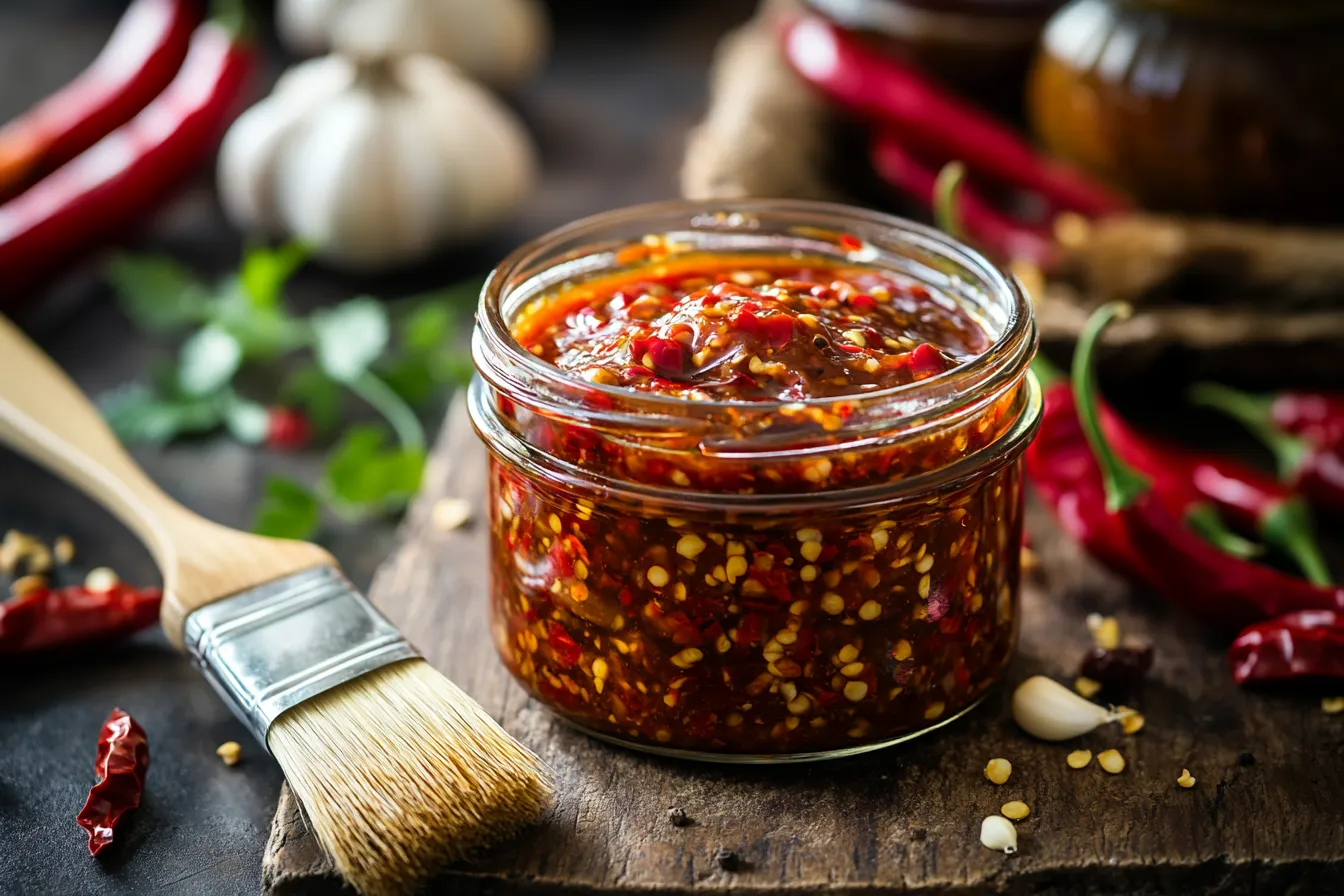Introduction
If you’ve ever wanted a sauce that delivers a symphony of sweet, spicy, and tangy flavors all in one bottle, tiger sauce might just become your new obsession. Bursting with complex layers of taste, tiger sauce has taken social media and foodie blogs by storm, earning praise for its versatility and tongue-tingling excitement. From drizzling over tacos to marinating smoky ribs, this magic sauce knows no boundaries.
But what exactly is tiger sauce? Why is everyone raving about it? And more importantly — how can you make it at home with minimal fuss and maximum flavor? In this in-depth guide, you’ll discover the roots of tiger sauce, its flavor profile, and exactly how to whip up a homemade version that will put any store-bought bottle to shame. We’ll also explore clever ways to use tiger sauce in everyday cooking and answer the most frequently asked questions..Yakiniku Sauce
Whether you’re a spicy food enthusiast or a sweet-sauce lover, you’ll find plenty to love in this one-of-a-kind recipe. So grab your whisk, and let’s dive into the world of tiger sauce!
What is Tiger Sauce?
Tiger sauce is a bold, vibrant, and balanced condiment that combines sweetness with a sharp vinegar tang and a moderate level of heat. Unlike purely hot sauces that focus on bringing the fire, tiger sauce aims for harmony. Think of it as a flavor booster that can adapt to almost any dish without overpowering the main ingredients.
Origins and History
While there is no single confirmed inventor of tiger sauce, its roots seem to trace back to the American South, where blending sweet and spicy condiments has long been a culinary tradition. Regional chefs found that mixing hot pepper sauces with sugar, vinegar, and spices produced a sauce that complemented fried chicken, grilled meats, and even seafood. Over time, commercial brands popularized “tiger sauce” in bottles, often promoting it as an all-purpose hot sauce with a sweeter twist.
Some food historians believe the name “tiger” was inspired by the sauce’s fierce bite and striped layers of flavor. Like a tiger in the wild, it’s powerful yet graceful — and it definitely leaves an impression.
Flavor Profile Explained
Tiger sauce is all about complexity. The flavor usually includes:
- A sweet backbone (often brown sugar or cane sugar)
- A vinegar tang that brightens and balances
- Chili peppers for mild to moderate heat
- Garlic and onion powder to add depth
- A hint of fruitiness, sometimes from pineapple or other tropical ingredients
The result is a sauce that hits multiple taste buds at once — sweet, sour, spicy, and even a little savory — making it an absolute workhorse for any kitchen.
Variations Around the World
While classic tiger sauce is rooted in American barbecue traditions, there are variations globally. In parts of Southeast Asia, cooks will add fish sauce or lemongrass to create a Southeast Asian-inspired tiger sauce. Caribbean cooks might throw in mango or scotch bonnet peppers for an island spin. The beauty of tiger sauce is how easy it is to adapt to your own personal tastes, so feel free to experiment once you’ve mastered the base recipe..Mango Habanero Sauce

Ingredients You Need for Homemade Tiger Sauce
Making tiger sauce at home is easier than you might think — and the best part is you can control exactly how sweet, spicy, or tangy it turns out. By selecting high-quality ingredients, you’ll unlock layers of flavor that store-bought bottles can’t match. Let’s dive into what you’ll need.
Must-Have Core Ingredients
The magic of tiger sauce comes from a handful of carefully chosen ingredients. Here’s a breakdown of what makes the sauce shine:
- Chili peppers or hot sauce: This is the heart of the tiger sauce’s mild to moderate heat. You can use a bottled hot sauce or fresh chili peppers blended down.
- Brown sugar or cane sugar: The sweetness is a key part of balancing the heat. Brown sugar brings a richer, caramel-like taste.
- Apple cider vinegar: Provides tang and acidity, balancing the sweetness perfectly.
- Garlic powder: Adds a savory backbone to keep the sauce from tasting too sugary.
- Onion powder: Another savory note that builds complexity.
- Worcestershire sauce: Adds umami and depth.
- Salt and black pepper: Round out the flavors and bring everything together.
Together, these ingredients build that iconic sweet-hot profile tiger sauce fans crave.
Optional Twists for Extra Kick
One of the best things about tiger sauce is how easy it is to personalize. Here are some fun variations you can add to kick things up a notch:
- Pineapple juice for a tropical sweetness
- Smoked paprika for a hint of smokiness
- Lime juice to brighten the flavor even more
- Ginger powder for a subtle bite
- Scotch bonnet peppers if you want it really fiery
These additions can take your homemade tiger sauce in countless creative directions, so don’t hesitate to experiment.
Where to Source the Best Ingredients
Quality matters, especially for a sauce you’ll want to use on everything. Here are a few quick tips on sourcing top-tier ingredients:
- Hot sauce: Choose a natural, preservative-free version to avoid off-flavors.
- Brown sugar: Organic brown sugar works best for a clean taste.
- Vinegar: Apple cider vinegar with the “mother” gives a more rounded tang.
- Fresh chilies: Farmers’ markets or specialty stores are ideal for getting ripe, vibrant peppers.
For a more sustainable option, buy from local producers. Supporting local farms means fresher ingredients and a richer, deeper flavor in your final sauce.

Step-by-Step Guide to Make Tiger Sauce
Ready to whip up your own batch of sweet-and-spicy tiger sauce? Follow these simple steps and you’ll have a jar of flavor magic in no time. Homemade means you can tweak the balance exactly how you love it.
Preparation Tips
Before you start mixing and simmering, keep these quick prep tips in mind:
- Mise en place: Measure all your ingredients ahead of time so you’re not scrambling once the pot is hot.
- Sanitize jars: If you plan to store your tiger sauce long-term, sterilize your jars to avoid bacteria growth.
- Taste as you go: Always check the flavor after each step so you can adjust sweetness, heat, or acidity to your liking.
- Ventilation: Hot sauce vapors can sting your eyes, so keep a window open or use a fan.
A little planning goes a long way in achieving perfect results.
Cooking Instructions
Here’s a straightforward recipe that captures the traditional tiger sauce flavor:
Ingredients:
- 1 cup hot sauce or pureed chili peppers
- ½ cup brown sugar
- ⅓ cup apple cider vinegar
- 1 tablespoon Worcestershire sauce
- 1 teaspoon garlic powder
- 1 teaspoon onion powder
- ½ teaspoon smoked paprika (optional)
- Salt and pepper to taste
Steps:
- Combine the ingredients in a small saucepan. Stir thoroughly to dissolve the sugar.
- Bring to a gentle simmer over medium heat. You’ll see small bubbles but don’t let it boil hard.
- Simmer for about 10 minutes, stirring occasionally so it doesn’t stick to the pan.
- Taste and adjust: If you want it sweeter, add more sugar. More tang? Add vinegar.
- Cool slightly, then transfer to a sterilized jar or bottle.
- Refrigerate and let it rest for 24 hours before first use — the flavors will deepen beautifully.
This base recipe is flexible. Feel free to experiment with extra spices or fruit juice once you’re comfortable.
Storage and Shelf Life
Tiger sauce keeps well if stored properly. Here’s how to make sure it stays safe and delicious:
- Store in an airtight glass container
- Keep refrigerated
- Consume within 2–3 weeks for best flavor
- If you made a very large batch, you can freeze in small portions (just defrost before using)
Always check for mold or off smells before using. As with any sauce, clean utensils are essential to avoid contamination.
For more on sauce safety, check out the Food Safety and Inspection Service guidelines to make sure you follow best practices.

Best Ways to Use Tiger Sauce
One of the reasons tiger sauce has gone viral is its incredible versatility. From meat to veggies, even snacks, this sweet and spicy condiment can transform the most ordinary foods into something crave-worthy. Here are some of the best ways to make tiger sauce the star of your kitchen.
Pairing with Meat and Seafood
Tiger sauce was practically made for protein dishes. Its blend of heat and sweetness cuts through the richness of meats and fish, adding balance and depth. Here’s where it shines:
- Chicken wings: Toss fried or baked wings in tiger sauce for a sweet-and-spicy coating.
- Pork ribs: Brush tiger sauce on ribs during the last few minutes of grilling for a sticky, flavorful glaze.
- Shrimp or fish tacos: Drizzle tiger sauce to boost flavor without overpowering the delicate seafood.
- Grilled steak: Serve it on the side instead of steak sauce for a unique twist.
If you’re a barbecue fan, you’ll find that tiger sauce easily rivals traditional BBQ sauce, especially on pulled pork or smoked brisket.
Using it on Vegetables and Salads
Tiger sauce isn’t just for carnivores — it’s a surprising hit on vegetarian dishes too. Here’s how to use it:
- Roasted vegetables: Toss carrots, cauliflower, or Brussels sprouts in tiger sauce before roasting for a caramelized, spicy finish.
- Salad dressing: Mix tiger sauce with olive oil and a splash of lime juice to create a bold, unique vinaigrette.
- Grilled tofu: Brush tiger sauce on tofu slices before grilling for maximum flavor absorption.
Because of its sweet and sour elements, tiger sauce blends beautifully with a huge variety of veggies.
Creative Ideas for Snacking and Marinades
Beyond traditional dishes, tiger sauce can add a zingy twist to your snack game and work as an outstanding marinade. Here are more unexpected uses:
- Popcorn: Drizzle a tiny bit over freshly popped corn for a sweet-hot snack.
- Nachos: Add a swirl of tiger sauce over cheesy nachos to bring them to life.
- Eggs: A dash of tiger sauce on scrambled eggs or omelets adds complexity and brightness.
- Marinades: Use it straight up or thin it with a little more vinegar to marinate chicken, shrimp, or even mushrooms before cooking.
The possibilities truly are endless. Don’t be afraid to get creative and invent your own signature tiger sauce dishes!
For even more ideas, you can visit Serious Eats to explore how foodies are incorporating hot sauces and sweet glazes into their everyday recipes.

Benefits of Tiger Sauce
Beyond the unforgettable taste, tiger sauce offers several benefits that make it a must-have condiment in any kitchen. From nutrition to enhancing your cooking, here’s why this sweet and spicy sauce deserves a permanent spot in your fridge.
Nutritional Benefits
While it’s still a sauce that should be enjoyed in moderation, tiger sauce can add positive nutritional qualities to your meals:
- Low in calories: Compared to creamy dressings or high-fat sauces, tiger sauce is relatively low in calories, making it a smarter choice for flavor.
- Natural ingredients: Homemade tiger sauce relies on simple spices, peppers, vinegar, and a small amount of sugar, steering clear of heavy preservatives or artificial dyes.
- Antioxidant potential: Chili peppers and garlic powder are rich in antioxidants, which may support immune health and reduce inflammation.
- Boosts appetite: The blend of sweet and spicy elements can stimulate appetite and make healthy foods like vegetables more enjoyable.
Of course, you should still keep an eye on sugar content if you use tiger sauce in large amounts — moderation is key!
Flavor Enhancement Benefits
Tiger sauce’s biggest benefit is how dramatically it can improve the taste of bland dishes. Here’s how:
- Balances flavors: It brings sweet, sour, and spicy notes that can correct bland or one-dimensional meals.
- Versatile pairing: Works with a wide range of dishes, from protein to vegetables, making it one of the most flexible sauces you can keep on hand.
- Convenient: A splash of tiger sauce can save a boring weeknight dinner in seconds, helping you serve meals with restaurant-style flavor at home.
Adding tiger sauce to your pantry means you’ll never struggle to find a flavor booster again.
FAQs
Is tiger sauce really spicy?
Tiger sauce is moderately spicy, but it’s more sweet and tangy than scorching hot. Most homemade recipes allow you to control the heat by adjusting the amount of chili or hot sauce.
How long does homemade tiger sauce last?
If you store it in a clean, airtight glass container in the fridge, homemade tiger sauce should stay fresh for up to 2–3 weeks. Always check for any off smells before using.
Can I make it less sweet?
Absolutely! You can reduce the brown sugar or substitute it with a sugar alternative like honey or agave syrup to match your taste preferences.
Is tiger sauce gluten-free?
Most homemade tiger sauce recipes are naturally gluten-free since they don’t use wheat-based ingredients. Always double-check your Worcestershire sauce or hot sauce labels if you have gluten sensitivities.
Can I freeze tiger sauce?
Yes, you can freeze tiger sauce in small freezer-safe jars or ice cube trays for up to 3 months. Thaw it overnight in the fridge before using.
For more details on chili pepper varieties you can use in tiger sauce, check out Chili Pepper Madness for a deep dive on different peppers and flavor profiles.
Conclusion
Tiger sauce is more than just another condiment; it’s a sweet, spicy, and tangy marvel that can transform even the simplest dish into something extraordinary. Its balance of sugar, vinegar, and heat makes it incredibly versatile — a perfect companion for meat, seafood, veggies, and even snacks.
The beauty of homemade tiger sauce is that you can control every ingredient, tweaking the heat, sweetness, and tanginess to suit your personal preferences. Whether you drizzle it on tacos, slather it on ribs, or whisk it into a bold salad dressing, tiger sauce will never fail to spark excitement on your plate.
If you haven’t tried making it at home yet, now’s the time. With easy-to-find ingredients and a simple cooking process, you’ll be on your way to enjoying a fresh, flavor-packed sauce that’s worlds better than anything you can buy in a bottle. So channel your inner kitchen tiger and get cooking — your taste buds will thank you!

Name: Tiger Sauce
Ingredients
Equipment
Method
- Instructions:
- Combine all ingredients in a small saucepan and stir thoroughly to dissolve the sugar.
- Bring to a gentle simmer over medium heat, stirring occasionally.
- Simmer for about 10 minutes, avoiding a rapid boil.
- Taste and adjust seasoning (more sugar for sweetness, more vinegar for tang).
- Cool slightly, then transfer to a sterilized glass jar or bottle.
- Store in the fridge for at least 24 hours before using to let flavors meld.

